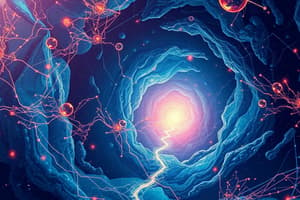Podcast
Questions and Answers
Which type of visual receptor is abundant in the periphery of the human retina?
Which type of visual receptor is abundant in the periphery of the human retina?
- Photopigments
- Opsins
- Rods (correct)
- Cones
In which lighting condition are cones more useful?
In which lighting condition are cones more useful?
- No light
- Bright light (correct)
- Dim light
- Faint light
What is the function of photopigments in vision?
What is the function of photopigments in vision?
- Regulating color vision
- Detecting brightness
- Releasing energy when struck by light (correct)
- Enhancing night vision
According to the Trichromatic Theory, how many colors can human eyes perceive?
According to the Trichromatic Theory, how many colors can human eyes perceive?
What is Color Constancy related to in vision?
What is Color Constancy related to in vision?
What is color vision deficiency commonly known as?
What is color vision deficiency commonly known as?
Which part of the eye is responsible for acute, detailed vision?
Which part of the eye is responsible for acute, detailed vision?
What is the blind spot in the eye caused by?
What is the blind spot in the eye caused by?
Which cells within the retina enable certain ones to respond mainly to particular visual features?
Which cells within the retina enable certain ones to respond mainly to particular visual features?
What is the main function of bipolar cells in the eye?
What is the main function of bipolar cells in the eye?
What is the purpose of the second cranial nerve (optic nerve) in vision?
What is the purpose of the second cranial nerve (optic nerve) in vision?
In terms of information encoding, how does the brain code information related to different sensations?
In terms of information encoding, how does the brain code information related to different sensations?
Flashcards are hidden until you start studying
Study Notes
Visual Receptors and Their Functions
- Rods are abundant in the periphery of the human retina, enabling better vision in low-light conditions.
- Cones are more useful under bright lighting conditions, responsible for color vision and visual acuity.
Photopigments and Color Perception
- Photopigments in the retina absorb light and initiate the phototransduction cascade, converting light into electrical signals for the brain.
- According to the Trichromatic Theory, human eyes can perceive three primary colors: red, green, and blue, which combine to form a wide spectrum of colors.
Color Vision and Adaptations
- Color constancy refers to the brain's ability to perceive colors consistently under varying lighting conditions despite changes in illumination.
- Color vision deficiency is commonly known as color blindness, affecting the ability to distinguish colors accurately.
Visual Processing and Acuity
- The fovea, located in the retina, is responsible for acute, detailed vision due to a high concentration of cones.
- The blind spot in the eye is caused by the absence of photoreceptors where the optic nerve exits the retina.
Cellular Function in the Retina
- Ganglion cells within the retina enable responses to specific visual features such as contrast and movement.
- Bipolar cells serve as intermediaries, transmitting signals from photoreceptors (rods and cones) to ganglion cells.
Causal Pathways in Vision
- The optic nerve (second cranial nerve) transmits visual information from the retina to the brain for processing.
- The brain encodes information related to different sensations through specific neural pathways, allowing distinct perception of various stimuli.
Studying That Suits You
Use AI to generate personalized quizzes and flashcards to suit your learning preferences.




